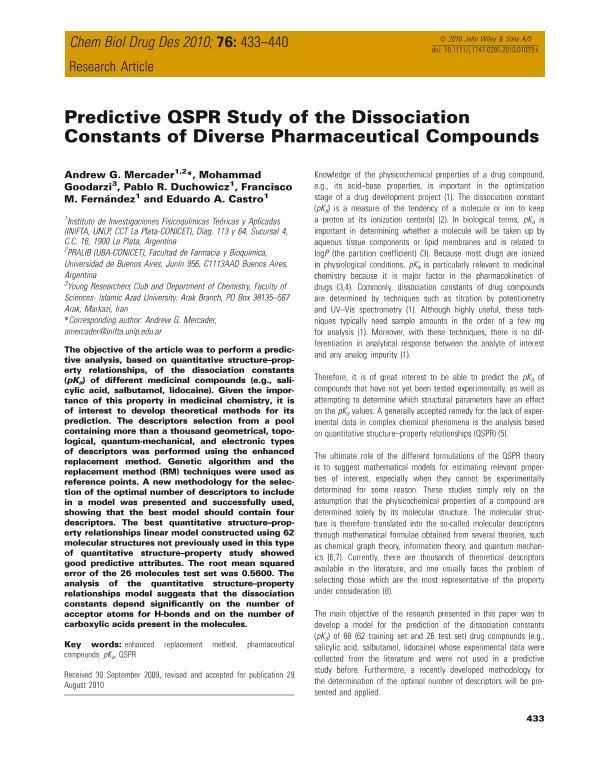Artículo
Predictive QSPR study of the dissociation constants of diverse pharmaceutical compounds
Mercader, Andrew Gustavo ; Goodarzi, Mohammad; Duchowicz, Pablo Román
; Goodarzi, Mohammad; Duchowicz, Pablo Román ; Fernández, Francisco Marcelo
; Fernández, Francisco Marcelo ; Castro, Eduardo Alberto
; Castro, Eduardo Alberto
 ; Goodarzi, Mohammad; Duchowicz, Pablo Román
; Goodarzi, Mohammad; Duchowicz, Pablo Román ; Fernández, Francisco Marcelo
; Fernández, Francisco Marcelo ; Castro, Eduardo Alberto
; Castro, Eduardo Alberto
Fecha de publicación:
11/2010
Editorial:
Wiley Blackwell Publishing, Inc
Revista:
Chemical Biology & Drug Design
ISSN:
1747-0277
Idioma:
Inglés
Tipo de recurso:
Artículo publicado
Clasificación temática:
Resumen
The objective of the article was to perform a predictive analysis, based on quantitative structure-property relationships, of the dissociation constants (pKa) of different medicinal compounds (e.g., salicylic acid, salbutamol, lidocaine). Given the importance of this property in medicinal chemistry, it is of interest to develop theoretical methods for its prediction. The descriptors selection from a pool containing more than a thousand geometrical, topological, quantum-mechanical, and electronic types of descriptors was performed using the enhanced replacement method. Genetic algorithm and the replacement method (RM) techniques were used as reference points. A new methodology for the selection of the optimal number of descriptors to include in a model was presented and successfully used, showing that the best model should contain four descriptors. The best quantitative structure-property relationships linear model constructed using 62 molecular structures not previously used in this type of quantitative structure-property study showed good predictive attributes. The root mean squared error of the 26 molecules test set was 0.5600. The analysis of the quantitative structure-property relationships model suggests that the dissociation constants depend significantly on the number of acceptor atoms for H-bonds and on the number of carboxylic acids present in the molecules. © 2010 John Wiley & Sons A/S.
Palabras clave:
Enhanced Replacement Method
,
Pharmaceutical Compounds
,
Pka
,
Qspr
Archivos asociados
Licencia
Identificadores
Colecciones
Articulos(IBIMOL)
Articulos de INSTITUTO DE BIOQUIMICA Y MEDICINA MOLECULAR
Articulos de INSTITUTO DE BIOQUIMICA Y MEDICINA MOLECULAR
Articulos(INIFTA)
Articulos de INST.DE INV.FISICOQUIMICAS TEORICAS Y APLIC.
Articulos de INST.DE INV.FISICOQUIMICAS TEORICAS Y APLIC.
Citación
Mercader, Andrew Gustavo; Goodarzi, Mohammad; Duchowicz, Pablo Román; Fernández, Francisco Marcelo; Castro, Eduardo Alberto; Predictive QSPR study of the dissociation constants of diverse pharmaceutical compounds; Wiley Blackwell Publishing, Inc; Chemical Biology & Drug Design; 76; 5; 11-2010; 433-440
Compartir
Altmétricas



